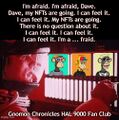Non-fungible tokens (nonfiction): Difference between revisions
m (Admin moved page Non-fungible tokens to Non-fungible tokens (nonfiction)) |
No edit summary |
||
| Line 33: | Line 33: | ||
* [[Gnomon algorithm]] | * [[Gnomon algorithm]] | ||
* [[Gnomon Chronicles]] | * [[Gnomon Chronicles]] | ||
* [[NFT is a like a deed to a house]] | |||
== Nonfiction cross-reference == | == Nonfiction cross-reference == | ||
Latest revision as of 04:40, 15 September 2023
A non-fungible token (NFT) is a unique digital identifier that cannot be copied, substituted, or subdivided.
Description
The digital identifier is recorded in a blockchain, and is used to certify authenticity and ownership. The ownership of an NFT is recorded in the blockchain and can be transferred by the owner, allowing NFTs to be sold and traded. NFTs can be created by anybody, and require few or no coding skills to create. NFTs typically contain references to digital files such as photos, videos, and audio. Because NFTs are uniquely identifiable assets, they differ from cryptocurrencies, which are fungible.
Proponents of NFTs claim that NFTs provide a public certificate of authenticity or proof of ownership, but the legal rights conveyed by an NFT can be uncertain. The ownership of an NFT as defined by the blockchain has no inherent legal meaning and does not necessarily grant copyright, intellectual property rights, or other legal rights over its associated digital file. An NFT does not restrict the sharing or copying of its associated digital file and does not prevent the creation of NFTs that reference identical files.
The NFT market grew dramatically from 2020–2021: the trading of NFTs in 2021 increased to more than $17 billion, up by 21,000% over 2020's total of $82 million. NFTs have been used as speculative investments, and they have drawn increasing criticism for the energy cost and carbon footprint associated with validating blockchain transactions as well as their frequent use in art scams. The NFT market has also been compared to an economic bubble or a Ponzi scheme. By May 2022, the NFT market was seen as beginning to collapse.
Commentary
One detail: the NFT is a record in an NFT broker database containing a URL.
The purchaser does not own the image. They own a URL which points to an image.
The URL in an NFT broker's database points to some asset: a JPG image, an MP3 file, an application program.
What the URL points to may change over time. Not the URL: that is unchanging. But the asset at the URL might change: one ape picture today, a different one later.
- Post @ Twitter (17 December 2022)
In the News
2001: An NFT Odyssey is a 1968 American science fiction NFT film about an advanced computer (HAL 9000) which attempts to market itself as non-fungible tokens.
Fiction cross-reference
Nonfiction cross-reference
External links
- Non-fungible token @ Wikipedia
- NFT is more like a Deed — Andreas Antonopoulos @ YouTube
- Understanding Punks and Apes and other Non-Fungible Tokens: Professor Carol Alexander MIT Ai & Quant @ YouTube
- What is an NFT? (Crypto Beginners) @ YouTube
- Crypto Explained: What Are NFT or Non Fungible Tokens? Why Should I Care? [2021] @ YouTube
- The vast majority of NFTs are now worthless, new report shows @ The Guardian - Two years after tech trend that swept up artists and celebrities, researchers estimate 23 million people hold worthless investments (22 September 2023)
Social media
- Post @ Twitter (19 December 2022)
